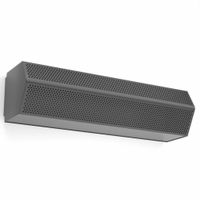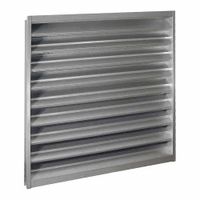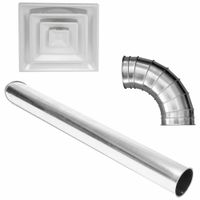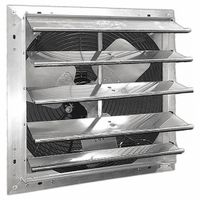Call +(254) 703 030 000 / 751 483 999 / 721 704 777
- Home
- Hvac And Refrigeration
- Ventilation Equipment
.....Read More
Frequently Asked Questions
What is the purpose of ventilation equipment in maintaining indoor air quality?
Ventilation equipment plays a crucial role in maintaining optimal indoor air quality by continuously replacing stale indoor air with fresh outdoor air. This process, known as air exchange, helps to remove various airborne pollutants that can accumulate within a building. These pollutants include volatile organic compounds (VOCs) emitted from furniture, cleaning products, and building materials, as well as allergens like dust mites and pollen, mold spores, bacteria, viruses, and carbon dioxide exhaled by occupants.
Without adequate ventilation, these contaminants can build up to unhealthy levels, leading to a range of issues. Poor indoor air quality can cause "sick building syndrome," characterized by symptoms such as headaches, fatigue, dizziness, and respiratory problems. It can also exacerbate existing conditions like asthma and allergies, reduce cognitive function, and decrease overall comfort and productivity.
Ventilation systems work by introducing filtered outdoor air, diluting indoor pollutants, and then exhausting the contaminated air. This prevents the recirculation of pollutants and helps to control temperature and humidity, further contributing to a healthier and more comfortable indoor environment. By effectively managing air exchange, ventilation equipment is essential for protecting the health and well-being of building occupants.
How do ventilation fans differ from blowers and air movers?
Ventilation fans, blowers, and air movers are all devices that move air, but they differ in their primary function, design, and typical applications.
Ventilation fans are primarily designed to circulate air within a space, often to remove stale air, odors, or heat, and introduce fresh air. They typically operate at lower static pressures and move a large volume of air. Common examples include exhaust fans in bathrooms or kitchens, and whole-house fans.
Blowers, also known as centrifugal fans, are designed to move air at higher static pressures and often direct air in a concentrated stream. They use impellers to draw air in and expel it centrifugally. Blowers are used in applications requiring forced air movement, such as in HVAC systems to push air through ducts, industrial drying processes, or for combustion air in furnaces.
Air movers, sometimes called carpet dryers or axial fans, are specifically designed to maximize airflow across a surface, often to facilitate drying or cooling. They typically produce a high-velocity, directed airstream over a specific area. Air movers are commonly used in water damage restoration to dry floors and carpets, or in construction to accelerate drying of paint or concrete.
In summary, while all three move air, ventilation fans focus on general air exchange, blowers on moving air against resistance or for concentrated delivery, and air movers on generating high-velocity airflow for surface drying or cooling.
What are the benefits of using energy- and heat-recovery ventilators?
Energy- and heat-recovery ventilators (ERVs and HRVs) offer significant benefits for indoor air quality and energy efficiency. These systems continuously exchange stale indoor air with fresh outdoor air while recovering a substantial portion of the energy used to heat or cool the indoor air.
HRVs are ideal for colder climates, as they transfer heat from the outgoing warm air to the incoming cold air, minimizing heat loss. This reduces the workload on heating systems, leading to lower energy consumption and costs. ERVs are more suited for climates with high humidity, as they transfer both heat and moisture, helping to maintain comfortable humidity levels indoors and preventing excessive dryness in winter or mugginess in summer.
Both ERVs and HRVs improve indoor air quality by continuously removing pollutants, allergens, and odors, which can accumulate in tightly sealed, modern homes. By providing a steady supply of fresh, filtered air, they help reduce the risk of respiratory issues and enhance overall comfort. They also prevent the buildup of excess moisture, which can lead to mold and mildew growth. Ultimately, these ventilators contribute to a healthier indoor environment and substantial energy savings.
How do draft inducers and combustion air systems work?
Draft inducers and combustion air systems are crucial for efficient and safe operation of heating appliances like furnaces, boilers, and water heaters.
Draft inducers are mechanical fans installed in the exhaust vent. Their primary purpose is to pull combustion byproducts (flue gases) out of the appliance and up the chimney or vent. This creates a negative pressure, or "draft," inside the combustion chamber, ensuring a consistent flow of air for proper burning. They are particularly useful when a natural draft is insufficient due to factors like chimney height, outdoor temperature, or horizontal vent runs. By mechanically inducing draft, they improve combustion efficiency, prevent back-drafting of harmful gases like carbon monoxide into the living space, and allow for more flexible venting configurations.
Combustion air systems, on the other hand, focus on supplying fresh air to the appliance for the combustion process. Appliances require a specific amount of oxygen to burn fuel cleanly and efficiently. In older homes, sufficient air might infiltrate naturally through cracks and gaps. However, modern, tightly sealed homes often require dedicated combustion air systems. These can range from simple vents that draw air directly from outside to more complex systems that preheat the incoming air. Adequate combustion air prevents incomplete combustion, which can lead to the production of soot and dangerous carbon monoxide, and ensures the appliance operates at its designed efficiency.
In essence, draft inducers ensure safe and effective removal of exhaust gases, while combustion air systems guarantee a constant supply of fresh air for optimal burning. Together, they create a balanced and safe combustion environment.
What role do air curtains play in maintaining indoor air quality?
Air curtains play a significant role in maintaining indoor air quality by creating an invisible barrier of air across an opening. This barrier prevents the infiltration of outdoor pollutants such as dust, pollen, insects, and vehicle exhaust fumes into the conditioned indoor space. By effectively sealing the entryway, air curtains help to maintain a cleaner indoor environment and reduce the burden on HVAC systems. They also help to contain conditioned air (heated or cooled), preventing it from escaping and thus reducing energy consumption. This contributes indirectly to air quality by reducing the need for the HVAC system to work harder, which can sometimes lead to the circulation of stale air or the accumulation of dust in overworked systems. In commercial and industrial settings, air curtains are particularly valuable for separating different environmental zones, such as a clean production area from a loading dock, thereby preventing cross-contamination of air.
How do dampers and louvers control airflow in a ventilation system?
Dampers and louvers are crucial components in ventilation systems, meticulously managing airflow to maintain optimal indoor air quality and temperature. Dampers are essentially valves or plates that regulate the flow of air within ductwork. They can be manually or automatically operated, allowing for precise control over the volume of air distributed to different zones of a building. For instance, a damper can be closed to restrict airflow to an unoccupied area, saving energy, or opened to increase ventilation in a heavily used space. Louvers, on the other hand, are typically found at the intake or exhaust points of a ventilation system, such as on the exterior walls of a building. They consist of angled blades designed to permit or restrict airflow while preventing the ingress of rain, debris, or pests. Some louvers are fixed, offering a constant level of ventilation, while others are adjustable, allowing for dynamic control over airflow and even sunlight penetration. Together, dampers and louvers provide a comprehensive solution for effective airflow management, ensuring that ventilation systems operate efficiently and meet the specific needs of a building's occupants.
What are the advantages of using duct and venting products in HVAC systems?
Duct and venting products are integral to the efficient operation of HVAC (Heating, Ventilation, and Air Conditioning) systems, offering numerous advantages that contribute to comfort, health, and energy efficiency.
One primary advantage is the effective distribution of conditioned air. Ducts create a closed pathway for heated or cooled air to travel from the HVAC unit to various rooms and zones within a building. This ensures that the desired temperature is maintained consistently throughout the space, preventing hot or cold spots and enhancing overall comfort for occupants. Without a well-designed ductwork system, conditioned air would not be evenly dispersed, leading to inefficiencies and discomfort.
Secondly, these products play a crucial role in maintaining indoor air quality. Venting systems facilitate the removal of stale, polluted, or humid air from indoor environments and the introduction of fresh outdoor air. This process, known as ventilation, helps to dilute and exhaust airborne contaminants such as allergens, dust, pollutants, and odors, which can accumulate indoors. By improving air circulation and freshness, duct and venting products contribute significantly to a healthier indoor environment, reducing the risk of respiratory issues and promoting well-being.
Furthermore, properly installed ductwork minimizes energy loss. Leaky or uninsulated ducts can lead to a significant waste of energy as conditioned air escapes before reaching its intended destination. High-quality duct and venting products, coupled with correct installation and sealing, ensure that air travels efficiently, reducing the workload on the HVAC system and ultimately leading to lower energy consumption and reduced utility bills. This energy efficiency is not only cost-effective for building owners but also beneficial for the environment.
Finally, these components contribute to the longevity and performance of the HVAC system itself. By ensuring proper airflow and preventing issues like excessive pressure drop or air stagnation, duct and venting products help the HVAC unit operate within its optimal parameters. This reduces wear and tear on the system's components, leading to fewer breakdowns, lower maintenance costs, and a longer operational lifespan for the entire HVAC installation.
How can ventilation equipment help reduce utility costs?
Ventilation equipment plays a crucial role in reducing utility costs by efficiently managing indoor air quality and temperature. Modern ventilation systems, such as energy recovery ventilators (ERVs) and heat recovery ventilators (HRVs), exchange stale indoor air with fresh outdoor air while recovering a significant portion of the energy used to heat or cool the indoor air. This process reduces the load on HVAC systems, as less energy is needed to bring the incoming fresh air to the desired temperature.
By improving indoor air quality, ventilation equipment can also lead to fewer instances of "sick building syndrome," which can reduce absenteeism and improve productivity, indirectly contributing to cost savings for businesses. Furthermore, proper ventilation prevents the buildup of humidity, which can lead to mold and mildew issues, saving on potential remediation costs. Smart ventilation systems with sensors can automatically adjust airflow based on occupancy and air quality, ensuring optimal energy usage and preventing unnecessary operation. This intelligent control minimizes energy waste, directly translating into lower electricity or gas bills for heating and cooling.
What factors should be considered when selecting ventilation equipment for a building?
When selecting ventilation equipment for a building, several key factors should be considered to ensure optimal performance, energy efficiency, and occupant comfort.
First, the building's purpose and occupancy dictate ventilation needs. For example, a hospital requires different air changes and filtration compared to an office building or a manufacturing plant. The number of occupants and their activities will also influence the required airflow.
Second, indoor air quality (IAQ) requirements are paramount. This includes addressing pollutants, allergens, and humidity levels. The type of filtration, air purification systems, and humidification/dehumidification capabilities of the equipment should align with the desired IAQ standards.
Third, energy efficiency is crucial for long-term operational costs. Look for equipment with high energy recovery efficiency, variable speed drives, and smart controls that can optimize performance based on occupancy and outdoor conditions. Energy-efficient options often lead to significant savings over the lifespan of the equipment.
Fourth, the climate and outdoor air conditions play a significant role. In hot, humid climates, equipment with robust dehumidification capabilities is essential. In cold climates, heat recovery ventilation (HRV) or energy recovery ventilation (ERV) systems are vital to minimize heat loss while providing fresh air.
Fifth, noise levels should be considered, especially in occupied spaces. Equipment with low sound power levels or options for sound attenuation can prevent disruption.
Finally, consider the equipment's maintainability, durability, and the availability of spare parts and service. Ease of installation and integration with existing building management systems (BMS) are also practical considerations.
How does proper ventilation impact health and comfort in indoor spaces?
Proper ventilation is crucial for maintaining a healthy and comfortable indoor environment. It works by continuously replacing stale indoor air with fresh outdoor air, thereby diluting and removing airborne pollutants. These pollutants can include volatile organic compounds (VOCs) emitted from building materials and furniture, allergens like dust mites and pollen, pet dander, mold spores, and airborne pathogens such as viruses and bacteria.
When ventilation is inadequate, these contaminants can accumulate to unhealthy levels, leading to a range of issues. Poor indoor air quality can exacerbate respiratory conditions like asthma and allergies, cause headaches, fatigue, dizziness, and irritation of the eyes, nose, and throat—symptoms often referred to as "Sick Building Syndrome." Long-term exposure to certain pollutants can also have more serious health consequences.
Beyond health, proper ventilation significantly impacts comfort. It helps regulate indoor temperature and humidity, preventing stuffiness and excessive moisture that can encourage mold growth. By removing odors and maintaining a fresh atmosphere, it contributes to a more pleasant and productive living or working space. In essence, effective ventilation is a foundational element of indoor environmental quality, directly influencing the well-being and satisfaction of occupants.







